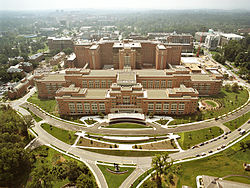 At age ten months, I became very ill and was rushed into the emergency room (ER). The doctors diagnosed me with dehydration and failure to thrive. In the following months, I went through many tests including bone marrow taken from my hip. The doctors concluded from these tests that I had Nephropathic Cystinosis. This was a very scary moment for my family, they had no idea what Cystinosis was.
At age ten months, I became very ill and was rushed into the emergency room (ER). The doctors diagnosed me with dehydration and failure to thrive. In the following months, I went through many tests including bone marrow taken from my hip. The doctors concluded from these tests that I had Nephropathic Cystinosis. This was a very scary moment for my family, they had no idea what Cystinosis was.

I owe my life to Dr. William Gahl from the National Institutes of Health (NIH). I began seeing him in 1992. Dr. Gahl shortly before meeting me he discovered that Cystagon and some other medications are successful in treating Cystinosis. I started the Cystagon treatment in 1992, during my first visit to the NIH. It is because of his research and those medication that I am still living. The first group of doctors, I saw at the University of Nebraska Medical Center were useless, they told my parents that they did not believe I would live to be six years old because they didn’t wish to go out of their way to really figure out what was wrong with me. Nevertheless, they were right, if I would not have started the Cystagon I would have died.
Cystinosis has become part of my life. Cystinosis had done many great things for me. I look at Cystinosis as some sort of tool. I have been able to educate myself on many things that most people do not understand because of this illness. I understand most if not all of what many of my medications do and how they work. I understand what Cystinosis does and what Cystinosis is; I know the many different functions of the body especially the kidneys and what levels should be. I am able to travel to many different places. For instance, I go to the NIH once every other year, which is located in Bethesda, Maryland just outside of Washington, D.C. It has given me the opportunity to travel to California where I took part in a psychology study in San Diego. Cystinosis has also made me become more mature then many people my age and thus, I look at the world much differently.
 Nonetheless, there are many negative aspects of living with Cystinosis, such as I have been to so many hospitals that I have lost count of them. The hands of so many medical professionals have touched me, which has led to me trying to tell them what to do, when they draw blood and start IVs. I have had so many different scans and X-rays that now, I have been exposed to more radiation then an average Iowan. I also take many different medication, which have many different side effects. Some of those side effects including vomiting, diarrhea, headaches, and bad breathe. Thus, the medications are another negative aspect of Cystinosis. But, I guess the most negative aspect of living with Cystinosis is that it will eventually kill me.
Nonetheless, there are many negative aspects of living with Cystinosis, such as I have been to so many hospitals that I have lost count of them. The hands of so many medical professionals have touched me, which has led to me trying to tell them what to do, when they draw blood and start IVs. I have had so many different scans and X-rays that now, I have been exposed to more radiation then an average Iowan. I also take many different medication, which have many different side effects. Some of those side effects including vomiting, diarrhea, headaches, and bad breathe. Thus, the medications are another negative aspect of Cystinosis. But, I guess the most negative aspect of living with Cystinosis is that it will eventually kill me.
Today, living with Cystinosis is much easier because I finally after 3 years of waiting and the first transplant center refusing to do the transplant after scheduling it twice in the same year, I got my kidney transplant. I am doing much better and continue to improve. I owe that to the University of Iowa Hospitals and Clinics and Dr. Reed who did my kidney transplant. Oh and I guess Jon the donor. But, he didn’t have a huge roll in it, he only had to lay on a table and give up his kidney. Thanks Jon!
The following are graphs of my blood levels post kidney transplant.







You must be logged in to post a comment.